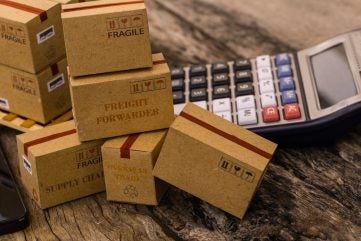
In the relentless pursuit of cost-effectiveness, businesses are often tempted by the allure of cheaper packaging solutions, aiming to trim operational expenses.
However, a more profound examination reveals that the seemingly economical route may hide underlying costs that outweigh the initial savings.
The hidden costs associated with cheap packaging present alternative strategies that businesses can adopt to reduce overall packaging expenses.
Why you should be wary of cheap packaging
In a business landscape characterised by rising prices and global inflation, the imperative of seeking value permeates every facet of operations. From industrial machinery to office supplies and stationery, overpaying for products can have a lasting impact on a company’s performance.
This focus on value is particularly pertinent when it comes to corrugated packaging.
While opting for the lowest unit cost may appear financially prudent on the surface, it could lead to unforeseen consequences that outweigh the initial savings.
The inherent question is whether cheap packaging is genuinely cost-effective or if under-specifying packaging is a false economy. Regardless, it is crucial for businesses to strike the right balance in their packaging choices.
Look beyond packaging unit costs
The temptation to base decisions solely on headline figures often results in choosing what appears to be the most cost-effective option.
However, a narrow focus on unit prices can overshadow hidden costs that may nullify any perceived gains or, worse, result in long-term financial losses.
When scrutinising packaging costs, it becomes crucial to consider how these costs interact with other facets of business operations.
Several real-world examples illustrating how cheap packaging choices can potentially backfire and offers insights on mitigating such impacts.
Minimising assembly times
One significant avenue for cost reduction involves minimising the time spent on packing and assembly.
Specialised packaging solutions, such as crash lock boxes, not only accelerate the assembly process but also contribute to a reduction in secondary packaging costs.
Despite the higher unit price of crash lock boxes, the overall cost, when factoring in labour savings, can be lower compared to standard taped boxes.
In practical terms, let’s consider a scenario where a standard taped box costs £0.25 each, and five staff members, paid £9.50 per hour, can assemble 50 boxes each in a given period.
The total labour cost of £47.50 allows for the assembly of 250 boxes. Contrastingly, a crash lock box, costing £0.33 per unit (32% more expensive), with the elimination of the taping process, allows each staff member to assemble four times as many boxes.
Despite the higher unit price, the overall cost for an assembled box is 16% lower at £0.43 each, showcasing the potential savings through efficient packaging choices.
Custom size packaging
Customising packaging sizes emerges as another avenue for substantial savings. Standard “stock” boxes, often associated with cheap packaging, may not efficiently utilise space and result in higher shipping costs.
By switching to custom-sized boxes, businesses can optimize space, potentially doubling the product capacity per pallet and realising a 25% overall cost reduction.
Consider a scenario where sending 5,000 standard boxes at a unit cost of £0.40 results in a total packaging cost of £2,000. However, due to the larger size, only 50 boxes can be put on a single pallet, necessitating 100 pallets at a shipping cost of £60 each. The total cost of packaging and shipping together works out at £8,000.
On the other hand, custom-sized boxes, optimizing space and accommodating twice as many products per pallet, with the same unit cost, require only 67 pallets.
This reduction in pallets saves a third on shipping costs, resulting in an overall cost of £6,000 and demonstrating a 25% cost saving.
Rationalisation of packaging
Another approach involves the rationalisation or simplification of the variety of box sizes used, leading to cost savings derived from economies of scale.
The graphic below illustrates a packaging inventory of six lines, each with a unit cost of £0.40 and a tooling charge of £250 per line.
Assuming equal orders for all lines and a total packaging requirement of 30,000 units, the overall packaging cost stands at £13,500.
By rationalising the inventory to only two box sizes, reducing tooling costs by two-thirds, and ordering 15,000 units of each, the unit costs drop, resulting in an overall packaging spend of £11,000 – an 18.5% saving over the six-line inventory.
However, it’s crucial to consider shipping costs, as rationalising lines can impact transit volume and, therefore, costs. Achieving a balance between simplifying inventory and optimising shipping volume is key to leveraging both tactics for cost-effectiveness.
Transit damage reduction
Arguably, the most impactful strategy for reducing packaging costs lies in minimising or eradicating transit damage. The figures, however, vary based on the volume of items shipped and the value of the products.
For instance, in a scenario involving mid volumes and mid-value products (e.g. LED TVs) with a unit cost of £1.00 for a standard box, sending 10,000 items results in a total packaging cost of £10,000.
However, if just 1% of these items (100 products) are damaged and returned, the costs skyrocket to £50,000, excluding additional transportation and administrative costs.
Investing in custom-engineered boxes designed to minimize damage, even with a unit cost 75% higher at £1.75, can yield significant savings.
If this can reduce the return rate by just half a percent, the cost of returned products drops by half too, providing a saving of approximately £25,000.
Despite the higher upfront packaging costs, the overall cost, when factoring in damaged products, sees a 29% saving – or £42,500 vs £60,000 (£17,500 total saving).
This figure doesn’t account for additional transit and administrative costs, but more importantly, it fails to consider customer satisfaction and the potential loss of repeat business.
Customers frequently receiving damaged products due to cheap packaging are less likely to reorder or recommend a company, impacting brand perception and customer loyalty.



